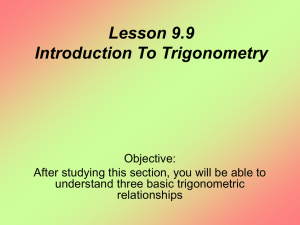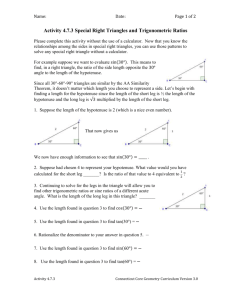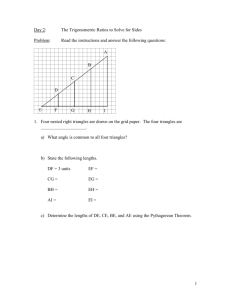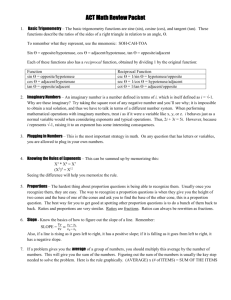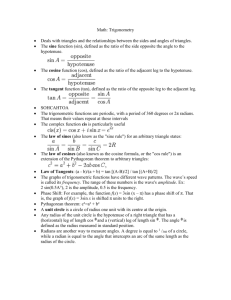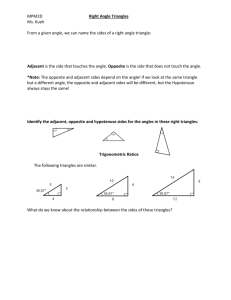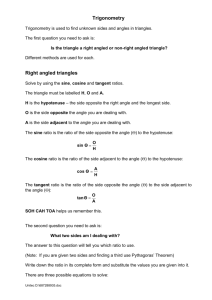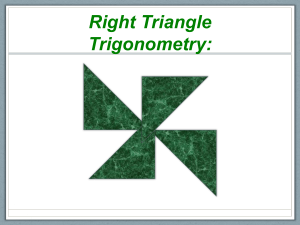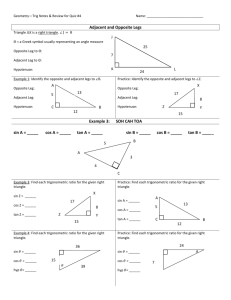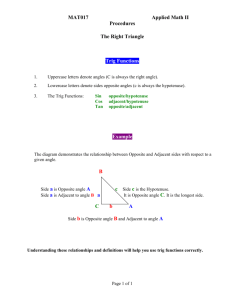Activity 4.6.1 Ratios in Right Triangles
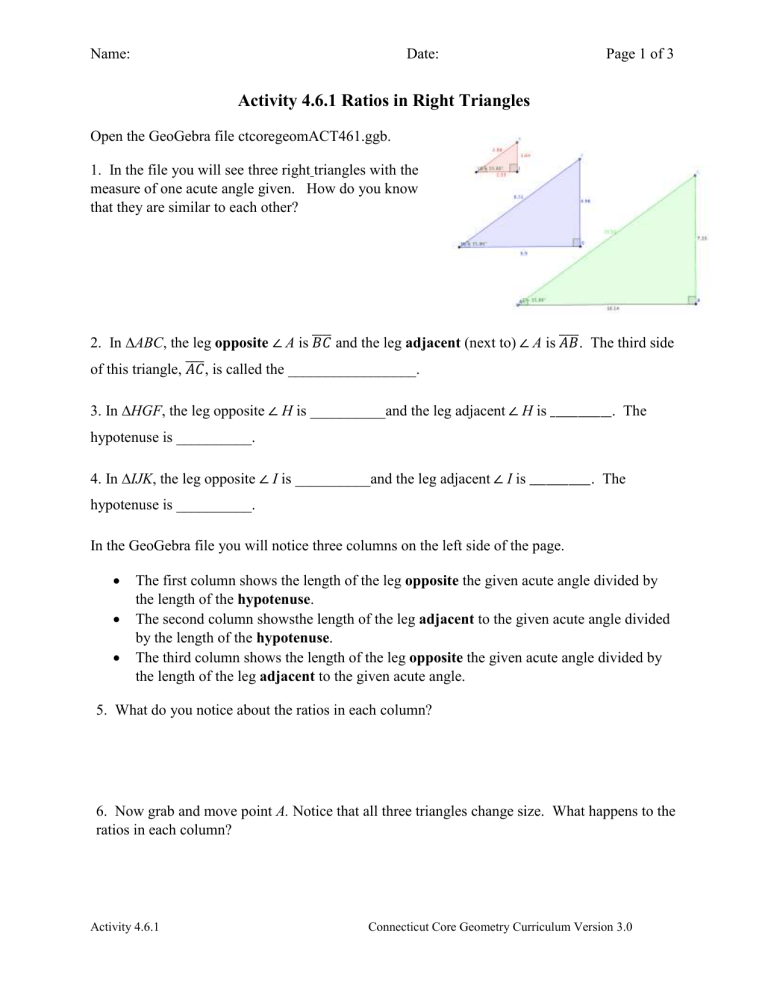
Name: Date: Page 1 of 3
Activity 4.6.1 Ratios in Right Triangles
Open the GeoGebra file ctcoregeomACT461.ggb.
1. In the file you will see three right triangles with the measure of one acute angle given. How do you know that they are similar to each other?
2. In ∆
ABC , the leg opposite ∠ A is 𝐵𝐶 and the leg adjacent (next to) ∠ A is 𝐴𝐵 . The third side of this triangle, 𝐴𝐶 , is called the _________________.
3. In ∆
HGF , the leg opposite ∠ H is __________and the leg adjacent ∠ H is ___________ . The hypotenuse is __________.
4. In ∆ IJK , the leg opposite ∠ I is __________and the leg adjacent ∠ I is ___________ . The hypotenuse is __________.
In the GeoGebra file you will notice three columns on the left side of the page.
The first column shows the length of the leg opposite the given acute angle divided by the length of the hypotenuse .
The second column showsthe length of the leg adjacent to the given acute angle divided by the length of the hypotenuse .
The third column shows the length of the leg opposite the given acute angle divided by the length of the leg adjacent to the given acute angle.
5. What do you notice about the ratios in each column?
6. Now grab and move point A. Notice that all three triangles change size. What happens to the ratios in each column?
Activity 4.6.1 Connecticut Core Geometry Curriculum Version 3.0
Name: Date: Page 2 of 3
When these relationships were first discovered for similar right triangles mathematicians named each ratio. a. The sine ratio is the ratio of the length of the leg opposite an acute angle to the length of the hypotenuse. (Abbreviation: sin ) b. The cosine ratio is the ratio of the length of the leg adjacent an acute angle to the length of the hypotenuse. (Abbreviation: cos ) c. The tangent ratio is the ratio of the length of the leg opposite an acute angle to the length of the leg adjacent the same acute angle. . (Abbreviation: tan )
It is important to always state both the name of the ratio you want to use along with the acute angle that you are referencing when you abbreviate. sin(𝛼) = 𝑙𝑒𝑔 𝑜𝑝𝑝. 𝛼 ℎ𝑦𝑝𝑜𝑡𝑒𝑛𝑢𝑠𝑒 cos(𝛼) = 𝑙𝑒𝑔 𝑎𝑑𝑗. 𝛼 ℎ𝑦𝑝𝑜𝑡𝑒𝑛𝑢𝑠𝑒 tan(𝛼) = 𝑙𝑒𝑔 𝑜𝑝𝑝. 𝛼 𝑙𝑒𝑔 𝑎𝑑𝑗. 𝛼
7.
Use the right triangle at the right to determine each of the following ratios.
a. sin(𝐴) = b.
sin(𝐶) = c. cos(𝐴) = d. cos(𝐶) = e. tan(𝐴) = f. tan(𝐶) =
8.
Use the right triangle at the right to determine each of the following ratios. a sin(𝐸) = c. cos(𝐸) = b.
sin(𝐹) = d. cos(𝐹) = e. tan(𝐸) = f. tan(𝐹) =
9. Draw a right triangle that shows tan(39 ∘ ) ≈
4
5
. Label the measures of all the sides and angles.
Activity 4.6.1 Connecticut Core Geometry Curriculum Version 3.0
Name: Date: Page 3 of 3
10.
In a right triangle, which side is the longest? What does this mean about the sine and cosine ratios?
Your calculator will give you decimal approximations for the trigonometric ratios SIN, COS, and
TAN. Be sure your calculator is in degree mode before you use it.
11.
Fill in this table with the appropriate trigonometric ratio. Round to the nearest 0.001
Angle ( 𝜃)
10°
20°
30°
40°
50°
60°
70°
80° sin 𝜃 cos 𝜃 tan 𝜃
12.
Describe any patterns you observe in the table above. a.
13.
In each right triangle, one acute angle and the length of one side are known. Use the trigonometric ratios on your calculator to find the length of the side marked x to the nearest 0.01. b. c.
Activity 4.6.1 Connecticut Core Geometry Curriculum Version 3.0
